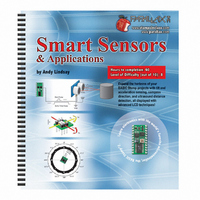122-28029 Parallax Inc, 122-28029 Datasheet - Page 112

122-28029
Manufacturer Part Number
122-28029
Description
GUIDE STUDENT SMART SENSORS
Manufacturer
Parallax Inc
Datasheet
1.122-28029.pdf
(340 pages)
Specifications of 122-28029
Accessory Type
Manual
Product
Microcontroller Accessories
Lead Free Status / RoHS Status
Contains lead / RoHS non-compliant
For Use With/related Products
Smart Sensors
Lead Free Status / RoHS Status
Lead free / RoHS Compliant, Contains lead / RoHS non-compliant
- Current page: 112 of 340
- Download datasheet (5Mb)
Page 100 · Smart Sensors and Applications
Note from the equations for Figure 3-27 that the x value can be at most the same as h
when θ = 0°. Likewise, the y value can be at most h when θ = 90°. For angles between 0
and 90°, the ratio of x/h and y/h are both less than 1. It doesn't matter how large the
triangle is, the ratio will always be between 1 and 0.
The unit circle is a common device for describing the sine and cosine functions. The
triangle's hypotenuse becomes the radius of the circle. The unit circle is so named
because the length of the hypotenuse is 1 (one unit). As the hypotenuse is rotated
counterclockwise, the angle θ becomes larger, or smaller if it is rotated clockwise. The
cosine is determined by drawing a vertical line from the point where the hypotenuse
meets the circle down (or up if the hypotenuse is below) to the x-axis. Whatever the x
value is, that's the cosine. The sine of the angle is determined by drawing a line from the
end of the radius horizontally to the y-axis.
Figure 3-28: Unit Circle Sine and Cosine Examples
a.
b.
c.
The range from 0 to 90° is the unit circle's Quadrant 1. When θ is in Quadrant 1, both the
cosine and sine of the angle will be positive numbers. When θ is between 90 and 180°
(Quadrant 2), the cosine becomes negative but the sine is still positive. In Quadrant 3,
both sine and cosine are negative, and in Quadrant 4, the sine is still negative but cosine
is positive again. Notice in Figure 3-28 (c) that a negative value of θ (between 0 and
−90) can be in Quadrant 4 just as a value between 270 and 360°. One other thing to keep
in mind here is that the minimum value for both sine and cosine is −1, and the maximum
value is 1. For example, when θ = 0°, cos θ = 1, and sin θ = 0. If θ = 90°, sin θ = 1 and
cos θ = 0. At θ = 180°, cos θ = −1 and sin θ = 0.
Related parts for 122-28029
Image
Part Number
Description
Manufacturer
Datasheet
Request
R

Part Number:
Description:
MANUAL FOR SUMOBOT
Manufacturer:
Parallax Inc
Datasheet:

Part Number:
Description:
GUIDE STUDENT PROCESS CONTROL
Manufacturer:
Parallax Inc
Datasheet:

Part Number:
Description:
MANUAL PROPELLER
Manufacturer:
Parallax Inc
Datasheet:

Part Number:
Description:
LEAD WIRES FLYING CABLE III/IV
Manufacturer:
Xilinx Inc
Datasheet:

Part Number:
Description:
BOARD ADAPTER AND FLY LEADS
Manufacturer:
Xilinx Inc
Datasheet:

Part Number:
Description:
PLATFORM CABLE USB II
Manufacturer:
Xilinx Inc
Datasheet:

Part Number:
Description:
KIT STARTER COOLRUNNER-II BUNDLE
Manufacturer:
Xilinx Inc
Datasheet:

Part Number:
Description:
Microcontroller Modules & Accessories DISCONTINUED BY PARALLAX
Manufacturer:
Parallax Inc

Part Number:
Description:
Microcontroller Modules & Accessories DISCONTINUED BY PARALLAX
Manufacturer:
Parallax Inc

Part Number:
Description:
BOOK UNDERSTANDING SIGNALS
Manufacturer:
Parallax Inc
Datasheet:

Part Number:
Description:
BOARD EXPERIMENT+LCD NX-1000
Manufacturer:
Parallax Inc
Datasheet:

Part Number:
Description:
IC MCU 2K FLASH 50MHZ SO-18
Manufacturer:
Parallax Inc
Datasheet:












